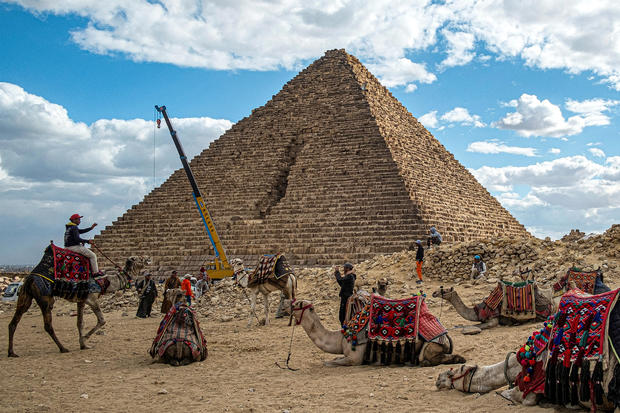Cairo — Archaeologists have launched a huge project to restore the smallest of Giza’s three famous pyramids to what they believe it looked like when it was built more than 4,000 years ago. An Egyptian-Japanese archaeological mission announced the project to put back in place hundreds of granite blocks that used to form the outer casing of the pyramid of King Menkaure, the smallest of the three main pyramids on the iconic Giza Necropolis.
Dr. Mostafa Waziry, Secretary-General of Egypt’s Supreme Council of Antiquities, said in a video statement that it would be the “project of the century,” calling it “Egypt’s gift to the world in the 21st century.”
KHALED DESOUKI/AFP/Getty
Waziry said there were about 124 pyramids in Egypt, and the only one known to have been built with an outer shell of granite blocks was the one constructed for King Menkaure around 2,150 BC. He said that while only the bottom five to eight rows of blocks remain in place, there were originally 16 to 18 rows of the huge pieces of granite covering the sides of the pyramid.
It’s not known when or how the blocks fell. Some experts believe they toppled about 800 years ago — but they are still there, some of them buried or partially buried, all around the base of the pyramid.
The plan is for archaeologists to carefully dig them up and reinstall them. The team is also hopeful that they could unearth other valuable antiquities in the process, hidden around or beneath the blocks.
Some archeologists, however, including a former head of Egypt’s antiquities ministry, aren’t on board with the project, and expressed concern as the digging got underway.
KHALED DESOUKI/AFP/Getty
Dr. Mohamed Abd El-Maqsoud, former Director of the Egyptian Antiquities Sector and a former senior official in Egypt’s antiquities ministry, told CBS News that before the granite blocks are moved, they should first be studied extensively to verify that they were all even part of the structure to begin with.
He said some of them were very likely not part of the pyramid itself, but rather were used in the massive ramp that led up to it during construction more than 4,000 years ago. Some of the blocks, he said, appeared to have never been polished, which he would expect from an external component of the structure.
“I believe that not all the blocks near the pyramid were part of the exterior casing,” Abd El-Maqsoud told CBS News. “Some of them belong to the funerary temple, some were never used because the king died, and his son didn’t complete the project.”
“The project is in its early stage of the studying and documenting and classifying the blocks, then they will share the results with an international committee,” Waziry told CBS News. “No action will be taken until the study is completed and no blocks will be reinstalled until the committee determines so.”
He said it would likely take about three years to complete the project, which would include studying the granite blocks using modern methods such as photogrammetry and laser scanning, before lifting and securing them back in place.



